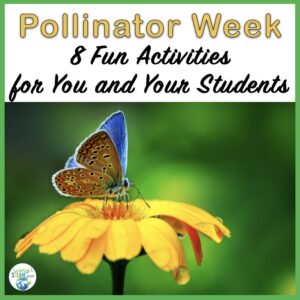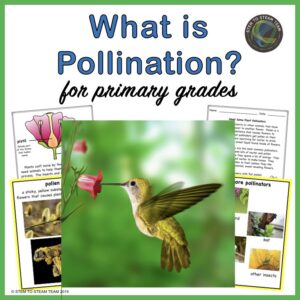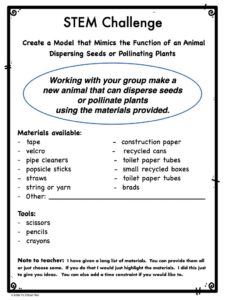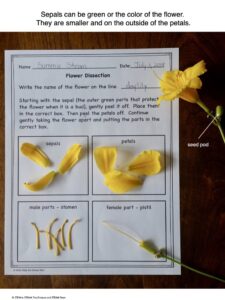National Pollinator Week is celebrated worldwide each year in June. The timing of it doesn’t coincide well with the school year. What is essential is that we teach kids about pollinators and their importance. Here are eight activities that will help you do just that! Pick out a few that are appropriate for your students.
What is Pollination?
There are many ways that you can teach students what pollination is. Ask children what they think it is. To find out more than just asking the class what pollination is, ask students to pair/share what they think it is. I find that students are freer with their responses that way. Thus, they are more willing to share.
Read a book to your class, such as The Reason for a Flower by Ruth Heller or What is Pollination? by Bobbie Kalman. If you don’t already have one of these books, your school librarian can help you find something suitable.
Students must know that we wouldn’t have flowers and plants without pollinators. But more importantly, we wouldn’t have food.
Watch a Video About Pollinators
Another good way to get students excited about learning about pollinators and what a pollinator does is by showing a video. This is a good student-friendly one. When the class is done watching the video, have them share anything new that they learned.
Read About Different Pollinators
When students think of a pollinator, they usually think of a bee. Some students will know that other insects are pollinators. Hummingbirds, hummingbird moths, bats, and some lemurs are also pollinators. In our resource, What is Pollination, we have paragraphs about each pollinator and pictures of each pollinator.
Research a Pollinator
Another great option is to ask students to research different pollinators. You can ask students to do this with a partner or in a small group for maximum engagement. Collect books from your library ahead of time. Or better yet, work with your librarian to have students do research during their library time. Students can also research the pollinator they chose online. Using more than one source helps students to meet state standards. Of course, having the students share what they have learned helps to spread the knowledge!
Do a Pollination Experiment or Challenge
One of the simplest experiments is to give students cheese puffs to eat. They can observe how much is on their fingers. What will happen if they pick up their pencil, tissue, or paper towel? It will spread. Ask them how this is like an organism that pollinates plants.
Ask pairs or small groups of students to create a model that mimics the function of an animal pollinating plants. The model can be sketches, drawings, or physical models. You can take this as far as you want, depending on your time constraints and the materials available. This can also be a good project for coordinating with your art teacher. Students need to know that pollinators have special structures to help them gather nectar and thus get pollen on themselves (long tongues, long beaks fur). Here are the materials and constraints that I give my students. Of course, you would modify it by only including pollination.
Dissect a Flower to Look at Reproductive Parts
In order for plants to reproduce, pollen from the stamen (male organs) must be carried to the pistil (female organ) by a pollinator or the wind. This fertilizes the ovule. This becomes a fruit with one or more seeds. If the conditions are right, the seeds will become new plants.
Dissecting a flower gives students a close-up look at these parts, thus a better understanding of the pollination process. Clicking on the photo above, you can get several worksheets that will save you lots of time and energy!
Plant Flowers that are Good for Pollinators
This project can be as simple as planting flowers out front of the school or as large as creating a school garden. The first thing you need to do is find out what type of flowers do well in the area that you live in. The website pollinator.org has free planting guides. All you need to do is enter your zip code, and they will find the right guide, which you can download. Guides are about 20 pages long and tell why we need to support pollinators, describe the habitat, have a map, include a paragraph about each pollinator in the area, tell you what plants do well there, and what the plants need.
STEM Project: Build a Bee Hotel
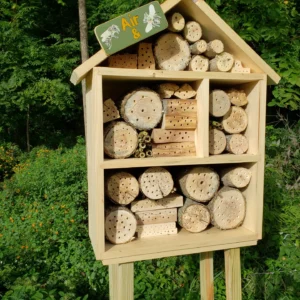
After seeing them at several environmental centers, my husband and I built this bee hotel for our backyard. This project would make a great addition to a school garden, especially if you can get help from a parent or your high school. Solitary bees use the tunnels as nesting sites.
Many sites online, such as Tree Hugger, have directions for making these accommodations.
PBS Kids has directions for a simple bee hotel that can be hung in a tree. Each student will need a can or water bottle, a toilet paper roll, twigs, scrap paper, string, and supplies for decorating.
So, choose an activity and have fun with your students while helping our pollinator friends!
If you are interested in other fun STEM activities, read these posts. Insects: Three Activities that Will Engage Students or Building a Nest: An Easy, Engaging, and Messy Activity.
And remember, it’s all science!

